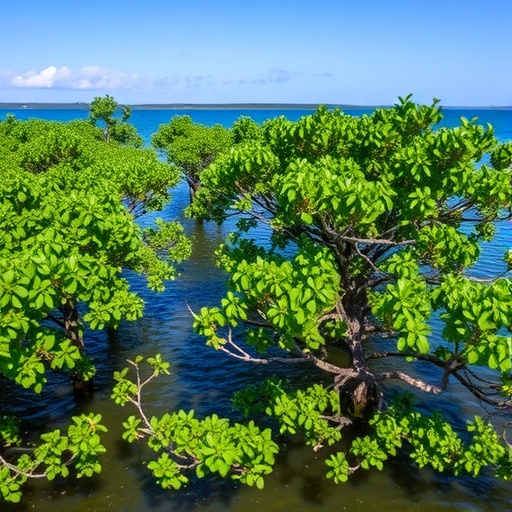In recent years, the alarming rise in vector-borne diseases has captured global attention, particularly due to the interplay of climate change, urbanization, and deforestation. These factors have created conducive environments for vectors such as mosquitoes to thrive, leading to outbreaks of diseases like malaria, dengue fever, and chikungunya. As public health remains a pressing concern, researchers are increasingly turning to innovative solutions that leverage technology and the principles of nature. A pioneering study sheds light on how unmanned aerial vehicles (UAVs) can significantly contribute to mangrove restoration, with the goal of mitigating vector-borne disease incidence.
Mangroves are indispensable ecosystems that play a dual role in both environmental preservation and public health. They provide a robust habitat for diverse wildlife while acting as natural barriers against coastal erosion and storm surges. However, the destruction of these vital ecosystems threatens not only biodiversity but also human health by increasing the prevalence of standing water—an ideal breeding ground for disease-carrying mosquitoes. Therefore, restoring mangrove habitats has emerged as a viable alternative for sustainable development and health protection.
The study led by Mohan and colleagues emphasizes the potential of UAVs in facilitating and accelerating mangrove restoration efforts. This technology enables researchers to reach otherwise inaccessible areas, conduct precise aerial surveys, and gather data on vegetation cover and hydrology. UAVs equipped with high-resolution imaging can provide invaluable information about ecosystems, enabling scientists to monitor changes, assess restoration success, and make informed decisions. This data-driven approach is essential for understanding the dynamics of mangrove ecosystems and their role in vector control.
Using drones for ecological assessment not only streamlines the restoration process but also significantly reduces the time and labor usually associated with such projects. Traditional methods often require extensive ground surveys, which can be time-consuming and labor-intensive. UAVs, on the other hand, offer an efficient means of acquiring data and mapping out areas where restoration is needed most. The study elucidates how UAV technology can be harnessed to identify priority zones, and assess the health of existing mangrove structures, thus creating a targeted restoration plan.
One of the standout findings of the study is the correlation between healthy mangrove ecosystems and reduced vector intensity. By planting mangroves in strategic locations, researchers noticed a significant decline in mosquito populations in restored areas. This phenomenon can be attributed to the way mangroves influence local hydrology—lowering stagnant water levels and improving drainage. Furthermore, mangroves naturally disrupt mosquito breeding due to their complex root structures, which inhibit the formation of standing water.
The implications of this research extend beyond just ecological benefits; they also highlight critical public health advancements. Vector-borne diseases are particularly prevalent in developing countries, where healthcare infrastructures may be challenged by outbreaks. By harnessing natural solutions like mangrove restoration to address these health issues, governments can implement more sustainable public health strategies that also support environmental conservation.
Another crucial aspect of the study is its focus on community involvement. Successful mangrove restoration initiatives demand the engagement of local communities to ensure sustainability. UAV technology can facilitate community involvement by offering a platform for citizen science, where local residents can participate in monitoring their environment through drone-based data collection. This participatory approach not only empowers communities but also fosters a sense of stewardship and responsibility toward local ecosystems.
Moreover, the integration of UAV technology with mangrove restoration strategies is a powerful example of interdisciplinary collaboration. Combining ecological science with engineering and technology fosters innovative solutions that can tackle complex environmental and public health challenges. Such collaborative frameworks promise to pioneer new strategies that can be replicated in different geographical regions facing similar threats from vector-borne diseases.
On an operational level, implementing UAV-supported mangrove restoration involves a series of stages, including site selection, aerial surveys, local collaborations, and ongoing monitoring. These stages require meticulous planning and coordination among various stakeholders—researchers, local governments, environmental NGOs, and community members—to ensure effective outcomes. The study outlines these processes step by step, providing a blueprint for future projects aiming to combine technology and nature for health and environmental benefits.
As we move toward an increasingly urbanized world, it is imperative to recognize the importance of preserving and restoring natural ecosystems. The mangrove restoration initiative discussed in this study serves as a beacon of hope—a testament to how human ingenuity can align with ecological wisdom to confront modern challenges. This pioneering approach highlights an essential paradigm shift: addressing public health concerns while simultaneously investing in environmental conservation.
The research presented also delves into the future trajectory of using UAV technology in ecological restoration. As the technology evolves, the capabilities of drones will expand, potentially integrating additional features such as automated seed dispersal systems. Such advancements could revolutionize restoration practices, enabling wider-scale implementation and improving efficiency in ecosystem recovery processes. Future studies could further explore the integration of machine learning algorithms with aerial data to predict ecosystem changes and optimize restoration methods.
In conclusion, the study conducted by Mohan et al. offers a compelling case for the integration of UAV technology in mangrove restoration efforts aimed at controlling vector-borne disease incidence. This innovative approach exemplifies the intersection of technology, ecology, and public health, paving the way for sustainable solutions in the face of growing environmental and health challenges. Ultimately, by understanding and supporting the delicate balance of our ecosystems, we can foster a healthier, more resilient future for both the planet and its inhabitants.
Subject of Research: UAV-supported mangrove restoration for controlling vector-borne disease incidence
Article Title: UAV-supported mangrove restoration: nature-based solutions for controlling vector-borne disease incidence
Article References:
Mohan, M., King, S.A.L., Moussa, L.G. et al. UAV-supported mangrove restoration: nature-based solutions for controlling vector-borne disease incidence.
Environ Monit Assess 197, 1346 (2025). https://doi.org/10.1007/s10661-025-14767-z
Image Credits: AI Generated
DOI: https://doi.org/10.1007/s10661-025-14767-z
Keywords: UAV technology, mangrove restoration, vector-borne diseases, public health, community involvement, environmental conservation.




